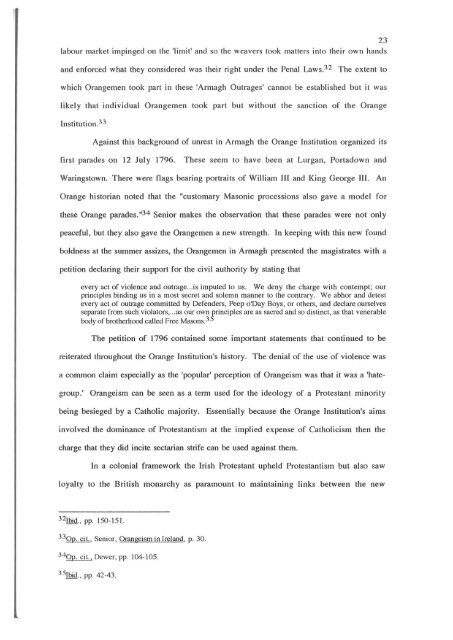TRANSPLANTED IRISH INSTITUTIONS - University of Canterbury
TRANSPLANTED IRISH INSTITUTIONS - University of Canterbury
TRANSPLANTED IRISH INSTITUTIONS - University of Canterbury
Create successful ePaper yourself
Turn your PDF publications into a flip-book with our unique Google optimized e-Paper software.
23<br />
labour market impinged on the 'limit' and so the weavers took matters into their own hands<br />
and enforced what they considered was their right under the Penal Laws.3 2 The extent to<br />
which Orangemen took part in these 'Armagh Outrages' cannot be established but it was<br />
likely that individual Orangemen took part but without the sanction <strong>of</strong> the Orange<br />
Institution.3 3<br />
Against this background <strong>of</strong> unrest in Armagh the Orange Institution organized its<br />
first parades on 12 July 1796.<br />
These seem to have been at Lurgan, Portadown and<br />
Waringstown. There were flags bearing portraits <strong>of</strong> William III and King George TIL<br />
An<br />
Orange historian noted that the "customary Masonic processions also gave a model for<br />
these Orange parades. "34 Senior makes the observation that these parades were not only<br />
peaceful, but they also gave the Orangemen a new strength. In keeping with this new found<br />
boldness at the summer assizes, the Orangemen in Armagh presented the magistrates with a<br />
petition declaring their support for the civil authority by stating that<br />
every act <strong>of</strong> violence and outrage ...is imputed to us. We deny the charge with contempt; our<br />
principles binding us in a most secret and solemn manner to the contrary. We abhor and detest<br />
every act <strong>of</strong> outrage committed by Defenders, Peep o'Day Boys, or others, and declare ourselves<br />
separate from such violators, ... as our own principles are as sacred and so distinct, as that venerable<br />
body <strong>of</strong> brotherhood called Free Masons. 35<br />
The petition <strong>of</strong> 1796 contained some important statements that continued to be<br />
reiterated throughout the Orange Institution's history. The denial <strong>of</strong> the use <strong>of</strong> violence was<br />
a common claim especially as the 'popular' perception <strong>of</strong> Orangeism was that it was a 'hategroup.'<br />
Orangeism can be seen as a term used for the ideology <strong>of</strong> a Protestant minority<br />
being besieged by a Catholic majority. Essentially because the Orange Institution's aims<br />
involved the dominance <strong>of</strong> Protestantism at the implied expense <strong>of</strong> Catholicism then the<br />
charge that they did incite sectarian strife can be used against them.<br />
In a colonial framework the Irish Protestant upheld Protestantism but also saw<br />
loyalty to the British monarchy as paramount to maintaining links between the new<br />
32Ibid., pp. ISO-lSI.<br />
330p. cit., Senior, Orangeism in Ireland, p. 30.<br />
34Op. cit. . Dewer, pp. 104-105.<br />
35Ibid., pp. 42-43.
















